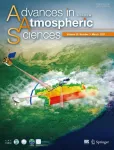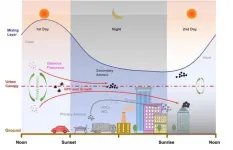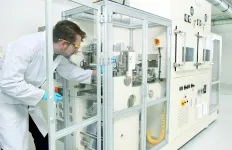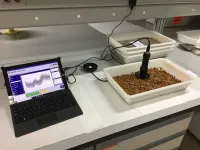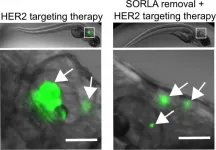(Press-News.org) An international team of scientists, coordinated by the Seville Institute of Biomedicine (IBiS) and the University of Seville has solved one of the hitherto unresolved enigmas of basic biology: how exactly do lipids distribute proteins within a cell? To do this, they used a new, completely innovative microscopy technology, which they applied to "mutant" cells they designed in their laboratory.
This discovery represents a major advance in understanding how proteins are distributed in cells to perform their vital functions, and could open the door to understanding the causes of diseases associated with failures in protein distribution at the cellular level: from cancer to neurodegenerative diseases, such as Alzheimer's.
The study was carried out by the Department of Cell Biology's "Membrane Trafficking" research group, part of the Faculty of Biology of the University of Seville and the IBiS, led by Professor Manuel Muñiz Guinea, in collaboration with the universities of Hiroshima (Japan), Geneva and Fribourg (Switzerland). The RIKEN Institute in Japan, where the "Super-resolution Living Cell Microscopy" Laboratory is located, also participated in this project. This is a unique facility in the world which conducted analyses using a high resolution fluorescence microscope that allows the study of very fast and dynamic processes in living cells on an incredibly small scale.
As Manuel Muñiz explains, "the cell is the basic unit of life and, at the same time, an extremely complex and sophisticated machine in which thousands of proteins, among other components, are strategically located in different compartments where they carry out cellular functions". The cell must ensure that its proteins are properly distributed to their place of function, because if this fails and they do not reach their destination, the proteins either stop working or get out of control, causing diseases ranging from genetic syndromes to cancer or neurological diseases. Therefore, it is important to investigate how proteins are distributed towards their functional destination.
Many years ago it was suggested that, in addition to cells' conventional protein transportation machinery (whose discovery received the Nobel Prize for Medicine in 2013), the lipids that make up the cell membranes may also play an additional role in the distribution of proteins within cells. This work by the Seville researchers solves this enigma of basic biology, demonstrating for the first time how lipids can distribute proteins at the cellular level.
Molecular exit doors
The proteins are manufactured in a compartment of the cell and then have to be distributed correctly by exiting through specific "doors". In this study, scientists from Seville discovered that membrane lipids are responsible for selecting and directing certain proteins to the correct exit doors.
To make this discovery, they designed a "mutant cell" that was programmed to manufacture a shortened version of cellular lipids called ceramides. The researchers suspected that the length of these lipids could be a determining factor in choosing the appropriate exit door.
"And that's exactly what we found," explains the IBiS researcher. "Thanks to the short ceramides we generated, we were able to demonstrate for the first time that lipids are only able to guide proteins during transport if they are the right length. Moreover, by using such a powerful 'super microscope' we were able to capture for the first time on an ultra small scale and in vivo how proteins exit through these molecular doors".
Yeast model
As a curiosity, this study was carried out using yeast cells (the same unicellular fungus used to make bread, beer and wine) as a model organism, "because, being eukaryotic cells just like ours, they perform the same basic cellular processes in a very similar way, so the observations can be extrapolated to human cells", explains the University of Seville professor.
However, because they are also simpler and can be genetically manipulated very effectively, "yeast cells are an excellent model to understand the fundamental workings of the human cell and what causes disease, as demonstrated by the fact that several Nobel Prize for Medicine have been awarded to researchers who used this microorganism in their studies, including Paul Nurse or Randy Schekman".
In conclusion, Manuel Muñiz explains that the article published in Science Advances "has also served to demonstrate that lipids and proteins influence each other to self-organise together within the cell", and points out that the mechanism they have discovered and used for this "could be used in other processes, such as the entry and exit of certain viruses from the cell, as well as in the formation of exosomes (extra-cellular lipid vesicles involved in communication between cells, particularly in cancer)".
INFORMATION:
Researchers have completed the first ever multi-level hydrological tracking of the Yangtze River from the ground, air and space in order to investigate the properties of cloud formation during the mei-yu--an intense rainy season that forms part of East Asia's summer monsoon. The effort should permit greater understanding of the mei-yu precipitation process and thus enable much more accurate forecasts of this key meteorological phenomenon in the region.
The mei-yu, also known as the "Plum Rain", is a period of severe, concentrated rainfall that lasts for up to two months during the late ...
Knowledge about health is a cornerstone in a child's development of physical and psychosocial health.
Since 2016, around 25,000 pupils in years 4-6 in 86 of Denmark's municipalities have taken part in the project "11 for Health in Denmark", an 11-week exercise and health education programme offered to all schools in a collaboration between the University of Southern Denmark and the Danish Football Association.
More than 3,000 of these pupils completed questionnaires before and after the programme aimed at determining their knowledge about health and understanding their experience of the 11-week programme.
An increase of 10 percentage ...
New particle formation (NPF) is a major source of aerosol particles in the global atmosphere. In polluted megacities, such as Beijing, the role of new particle formation events and their contribution to haze formation through subsequent growth is still unclear.
To improve the understanding of the sources, meteorological conditions, and chemistry behind air pollution, the research teams led by Prof. Yele Sun with the Institute of Atmospheric Physics at the Chinese Academy of Sciences and Prof. Markku Kulmala with the University of Helsinki performed simultaneous measurements ...
Research on manufacturing battery cells is gaining momentum - and there is a strong need, considering the future demand for energy storage: For the year 2030, global production of rechargeable batteries will double from today's 750 gigawatt hours (GWh) per year to 1,500 GWh. A recently published review article in the magazine "Nature Energy" on cell production of various battery types suggests that the currently established lithium-ion batteries (LIB) dominate the market of rechargeable high-energy batteries in the coming years. Alternative battery technologies, ...
Large parts of today's Sahara Desert were green thousands of years ago. Prehistoric engravings of giraffes and crocodiles testify to this, as does a stone-age cave painting in the desert that even shows swimming humans. However, these illustrations only provide a rough picture of the living conditions. Recently, more detailed insights have been gained from sediment cores extracted from the Mediterranean Sea off the coast of Libya. An international research team examined these cores and discovered that the layers of the seafloor tell the story of major environmental changes in North Africa over ...
The biological process of photosynthesis is found at the beginning of nearly all food chains. It produces oxygen to breathe and provides the energetic foundation for using biotechnological processes to synthesize biofuels and chemical feedstock. Therefore, researchers are particularly interested in rapidly growing cyanobacteria. These organisms use light as an energy source and can carry out photosynthesis, similar to plants. However, the required photosynthetic protein complexes bind many nutrients. Vanessa Krauspe and Prof. Dr. Wolfgang Hess from the working group for Genetics & Experimental Bioinformatics of the Faculty of Biology of ...
Who hasn't at some point been chewing on an almond and tasted an unpleasant and unexpected aftertaste that has nothing to do with the taste we are used to from one of the most consumed nuts in the world? The culprit has a name: amygdalin, a diglucoside that, when in contact with enzymes present in saliva, breaks down into glucose, benzaldehyde (the cause of the bitter taste) and hydrogen cyanide.
To reduce this unpleasant 'surprise', the Farming Systems Engineering (AGR-128) and Food Technology (AGR-193) research groups at the University of Cordoba's School of Agricultural and Forestry Engineering, ...
SORLA is a protein trafficking receptor that has been mainly studied in neurons, but it also plays a role in cancer cells. Professor Johanna Ivaska's research group at Turku Bioscience observed that SORLA functionally contributes to the most reported therapy-resistant mechanism by which the cell-surface receptor HER3 counteracts HER2 targeting therapy in HER2-positive cancers. Removing SORLA from cancer cells sensitized anti-HER2 resistant breast cancer brain metastasis to targeted therapy.
HER2 protein is a strong driver of tumor growth. HER2 amplification occurs ...
High-intensity tropical cyclones have been moving closer to coasts over the past 40 years, potentially causing more destruction than before.
The trend of tropical cyclones - commonly known as hurricanes or typhoons - increasingly moving towards coasts over the past 40 years appears to be driven by a westward shift in their tracks, say the study's authors from Imperial College London.
While the underlying mechanisms are not clear, the team say it could be connected to changes in tropical atmospheric patterns possibly caused by climate change. The research is published today in Science.
Globally, 80 to 100 cyclones develop over tropical oceans each year, impacting regions in the Pacific, ...
New research by Mimi E. Lam (University of Bergen) just published in Humanities and Social Sciences Communications identifies and explores the impacts of salient viral or COVID-19 behavioural identities that are emerging.
"These emergent COVID-19 behavioural identities are being hijacked by existing social and political identities to politicize the pandemic and heighten racism, discrimination, and conflict," says Lam. She continues: "the COVID-19 pandemic reminds us that we are not immune to each other. To unite in our fight against the pandemic, it is important to recognize the basic dignity of all and value the human diversity currently dividing us."
"Only ...
